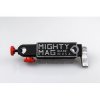Ian
Notorious member
Thanks for the input, fellas. I have a lot of the measuring tools already (I already have a "hobby machine shop" and full line of reloading and engine-building measuring tools), but need a couple more odds and ends like thread pitch wires, Last Word indicator, maybe an extra-long stroke dial indicator w/magnet base, stuff like that. Somehow I've managed to live 42 years without owning a single numbered or letter-size drill, I see that changing very fast.



